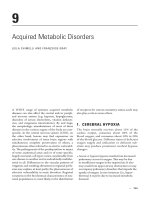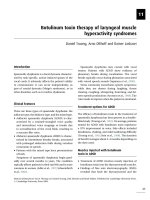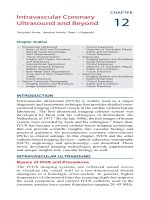Ebook Manual of otologic surgery: Part 2
Bạn đang xem bản rút gọn của tài liệu. Xem và tải ngay bản đầy đủ của tài liệu tại đây (5.22 MB, 35 trang )
6
Alternative Approaches
to the Cochlea
Finding a patent cochlea may be very challenging in
postmeningitic patients with labyrinthis ossificans. A myriad of cochlear drill out procedures including access to the
scala vestibuli and mid/apical cochleostomies have been
described.
Scala Vestibuli Approach
Landmarks
• Facial recess
• Facial nerve tympanic
segment
• Round window
• Oval window niche
• Stapedial tendon
• Long process of the
incus
• Incudostapedial joint
• Tensor tympani muscle
Due to pathophysiological mechanisms that are not fully
understood, the process of postmeningitic ossification of
the inner ear often starts in the lateral semicircular canal,
then reaches the scala tympani and finally affects both
scalae in a basal to apical progress pattern. Whereas the
status of the lateral SCC serves as an important marker
for early detection of ossification by MRI, the fact that
the scala vestibuli is often spared from ossification initially renders it an important alternative route for electrode insertion.
After the scala tympani is drilled open for a few millimeters and no lumen can be found, a scala vestibuli
approach is performed: The incus and stapes suprastructure are removed. The footplate of the stapes is left
in place.
© Springer-Verlag Wien 2015
C. Arnoldner et al., Manual of Otologic Surgery, DOI 10.1007/978-3-7091-1490-2_6
31
32
6
Alternative Approaches to the Cochlea
Fig. 6.1 A tympanomeatal flap is raised and an atticotomy is performed to visualize the middle ear
structures. After removal of the incus and stapes suprastructure, a scala vestibuli cochleostomy is drilled
in the anterior niche of the oval window (RW round window, FP footplate, asterisk facial nerve, dashed
line indicates area of scala vestibuli cochleostomy)
Fig. 6.2 Scala vestibuli cochleostomy and electrode insertion seen through facial recess (RW round
window, FP footplate)
Landmarks
• Facial recess
• Facial nerve tympanic
segment
• Round window
• Oval window niche
• Stapedial tendon
• Long process of the
incus
• Incudostapedial joint
• Tensor tympani muscle
The cochleostomy of the scala vestibuli is performed in
the anterior niche of the oval window, lateral to the spiral
ligament (Figs. 6.1 and 6.2).1
Middle/Apical Turn Cochleostomy
If a lumen cannot be found in the basal turn of the
cochlea in either scalae, a superior (middle or apical
turn) cochleostomy can be performed. For this approach,
1
Kiefer J et al., Scala vestibuli insertion in cochlear implantation:
a valuable alternative for cases with obstructed scala tympani. ORL
J Otorhinolaryngol Relat Spec. 2000.
6
Alternative Approaches to the Cochlea
33
Fig. 6.3 After atticotomy and removal of the incus, a superior cochleostomy is drilled anterior to the oval
window niche and just inferior to the tensor tympani muscle and cochleariform process (RW round window, S stapes, I incus, TT tensor tympani, M malleus, SH stapes head, ST stapedial tendon, FP footplate,
FN facial nerve, dashed line indicates area of superior cochleostomy)
a tympanomeatal flap is raised, and an atticotomy is performed with a 1.5-mm diamond drill to improve visualization of the middle ear structures. If not already done
during a scala vestibuli approach, after separation of the
incodostapedial joint with a 45° hook or a joint knife, the
incus is removed.
A cochleostomy is drilled approximately 2 mm anterior
to the oval window margin and just inferior to the cochleariform process (tensor tympani; Figs. 6.3 and 6.4). The
electrode can then either be inserted in an antero- or retrograde manner.2 The localization is very similar to the scala
vestibuli approach, and due to variations in anatomy (size,
rotation of cochlea) it is often rather unclear for the surgeon which part of the cochlea is opened until radiological
studies are performed.
2
Senn P et al. Retrograde cochlear implantation in postmeningitic
basal turn ossification. Laryngoscope. 2012.
Landmarks
• Facial recess
• Facial nerve tympanic
segment
• Round window
• Oval window niche
• Stapedial tendon
• Long process of the
incus
• Incudostapedial joint
• Tensor tympani muscle
34
6
Alternative Approaches to the Cochlea
Fig. 6.4 The superior cochleostomy is drilled and an electrode is inserted into the cochlea (RW round
window, SH stapes head, CO cochleostomy, TT tensor tympani)
Landmarks
• Arcuate eminence
• Greater superfical
petrosal nerve
• Internal auditory canal
• Facial nerve
• Cochlea
Middle Fossa Approach to the Cochlea
An approach via the middle cranial fossa was described
mainly for ears with chronic inflammation. Due to the
invasiveness of this procedure this approach is rarely used
and mentioned herein only for the sake of completeness.
As in a middle fossa approach to the IAC, a temporal craniotomy is performed, the temporal lobe is retracted and
the cochlea is localized (Fig. 13.7):3,4 The lack of constant
landmarks and the variation in anatomic features make this
procedure extremly challenging even for experienced surgeons. After identification of the superior semicircular
canal and the greater superfical petrosal nerve, the IAC is
identified and blue lined in a medial to lateral fashion.
Once the lateral wall of the IAC is located drilling proceeds anterolaterally until the cochlear basal turn is identified and opened.
3
Colletti V, Fiorino FG. New window for cochlear implant insertion.
Acta Otolaryngol 1999.
4
Bento RF et al. Cochlear implantation via the middle fossa approach:
surgical and programming considerations. Otol Neurotol. 2012.
7
Unroofing the Epitympanum
In chronic otitis media, cholesteatoma formation classically starts in the space just medially to the pars flaccida
portion of the tympanic membrane and the scutum (a sharp
bony spur formed by the lateral wall of the tympanic cavity
and the superior wall of the external auditory canal, usually
the first bony structure to erode as a result of a cholesteatoma). This space is referred to as Prussak’s space. It continues posteriorly to become the epitympanum. So, to
access this space posteriorly, it is necessary to unroof the
epitympanum. This is done by removing air cells in the root
of the zygoma between the middle fossa dura and the
thinned posterior canal wall until the head of the malleus
and the incudomalleolar joint are identified (Figs. 2.9 and
2.10). The floor of the dissection is the tympanic portion of
the facial nerve and the superior semicircular canal. If necessary, the dissection can be carried anteriorly through the
zygomatic root to the glenoid fossa. In the anterior epitympanum, after removal of the head of the malleus and the
body of the incus, a bony spicule (the cog) descending from
the tegmen can sometimes be identified (Fig. 8.1). This
spicule separates the epitympanum in anterior and posterior
compartments. If present, this landmark can be identified
on pre-operative CT scans and needs to be removed in
order to fully remove disease in the anterior epitympanum.
Landmarks
• Horizontal semicircular
canal
• Short process of incus
• Tympanic segment of
the facial nerve
• Head of the malleus
• Incudomalleolar joint
• Cog
© Springer-Verlag Wien 2015
C. Arnoldner et al., Manual of Otologic Surgery, DOI 10.1007/978-3-7091-1490-2_7
35
8
Canal Wall Down (Radical Cavity)
The posterior canal wall is taken down mainly in cholesteatoma cases when a wide overview of the middle ear
structures is necessary. Initially the canal wall is usually
preserved to have a landmark for the mastoidectomy.
When the canal wall is then taken down, drilling is performed parallel to the facial nerve. Once you are medial to
the tympanic annulus, it is important to take down the bone
overlying the facial nerve (“facial ridge”) as much as possible to allow cleaning and inspection of the middle ear
space (Video 5). This is known as lowering the facial ridge
and an important step to reduce the incidence of leaving
cholesteatoma matrix behind. In this context, also the
importance of a wide meatoplasty should be highlighted
(Video 6). Once the canal wall is removed, the entrance
into the eustachian tube and the canal of the tensor tympani can be seen. The carotid artery lies medial to the
eustachian tube (Fig. 8.1).
Landmarks
• Horizontal semicircular
canal
• Tympanic segment of
the facial nerve
• Head of the malleus
• Incudomalleolar joint
• Cog
• Tensor tympani
• Eustachian tube
• Supratubal recess
• Carotid artery
Electronic supplementary material Supplementary material is
available in the online version of this chapter at 10.1007/978-3-70911490-2_8. Videos can also be accessed at ingerimages.
com/videos/978-3-7091-1489-6.
© Springer-Verlag Wien 2015
C. Arnoldner et al., Manual of Otologic Surgery, DOI 10.1007/978-3-7091-1490-2_8
37
38
8
Canal Wall Down (Radical Cavity)
Fig. 8.1 The posterior canal wall is taken down to gain a wide overview of the middle ear structures
(L-SCC lateral semicircular canal, TT tensor tympani, S stapes, asterisk cog, SR supratubal recess, CTT
canal of tensor tympani, CA carotid artery, ET eustachian tube)
9
Skeletonizing the Facial Nerve
A diamond burr is used to skeletonize the facial nerve in its
descending (mastoid) portion. As mentioned, the direction
of preparation should always be parallel to the course of
the nerve. The nerve should be skeletonized broadly using
slow deliberate strokes of the drill. Excessive hand movement should be avoided to minimize inadvertent injury to
the facial nerve.
᭤ It is important to understand that the most proximal part
of the labyrinthine portion of the facial nerve, as well as the
geniculate ganglion, cannot be exposed via the mastoid
without performing a labyrinthectomy or a middle fossa
approach. The meatal foramen in particular, which is the
narrowest point of the fallopian canal and should always be
included if the whole intratemporal facial nerve is meant to
be decompressed, can only be reached via the middle fossa
or translabyrinthine routes (Fig. 9.1).
Landmarks
• Horizontal semicircular
canal
• Mastoid segment of the
facial nerve
• Tympanic segment of
the facial nerve
• Labyrinthine segment
of the facial nerve
• Meatal segment of the
facial nerve
• Geniculate ganglion
• Retrofacial air cell tract
© Springer-Verlag Wien 2015
C. Arnoldner et al., Manual of Otologic Surgery, DOI 10.1007/978-3-7091-1490-2_9
39
40
9
Skeletonizing the Facial Nerve
Fig. 9.1 The facial nerve has been decompressed in its whole intratemporal course (FNm mastoid segment of facial nerve, asterisk second genu, FNt tympanic segment of facial nerve, GG geniculate ganglion, FNl labyrinthine segment of facial nerve, FNme meatal segment of facial nerve, RF retrofacial air
cell tract, CT chorda tympani)
10
Endolymphatic Sac Dissection
(Retro-/Infralabyrinthine)
The endolymphatic sac (ELS) can be found in a thickened
portion of the posterior fossa dura medial to the sigmoid
sinus and inferior to the posterior canal. A classic landmark that consistently defines the upper boundary of the
ELS is known as “Donaldson’s line”. This line is drawn
through the lateral semicircular canal (SCC), which
bisects the posterior SCC; the ELS is usually at and below
this line.
After completing a cortical mastoidectomy with identification of the lateral SCC, the posterior SCC should be
delineated by removing the surrounding perilabyrinthine
air cells. The approximate location of the vertical segment
of the fallopian canal can be identified by the relative anatomy of the SCCs and the posterior canal wall, which is
gradually thinned out. The fallopian canal is further delineated from behind while skeletonizing the sigmoid sinus
and removing the retrofacial air cells. In this manner, the
bone deeper (medial) to the sigmoid sinus is gradually
removed to reveal the posterior fossa plate that covers the
dura and the ELS (Figs. 10.1, 10.2 and 10.3). If the sigmoid sinus is very prominent or very anterior, the overlying bone may have to be uncovered partially or completely
to permit compression and exposure of the ELS. When the
bony plate over the dura is removed anterior to the sigmoid
sinus, the ELS becomes recognizable as a thickened area
at and below the Donaldson’s line.
Landmarks
• Horizontal semicircular
canal
• Short process of incus
• Superior semicircular
canal
• Posterior semicircular
canal
• Common crus
• Fallopian canal
• Posterior fossa dural
plate
• Endolymphatic sac
• Endolymphatic duct
© Springer-Verlag Wien 2015
C. Arnoldner et al., Manual of Otologic Surgery, DOI 10.1007/978-3-7091-1490-2_10
41
42
10
Endolymphatic Sac Dissection (Retro-/Infralabyrinthine)
*
Fig. 10.1 Localization of the endolymphatic sac; the Donaldson’s line is an imaginary line through the
horizontal semicircular canal and defines the upper limit of the endolymphatic sac (asterisk)
Landmarks
• Horizontal semicircular
canal
• Short process of incus
• Superior semicircular
canal
• Posterior semicircular
canal
• Common crus
• Fallopian canal
• Posterior fossa dural
plate
• Endolymphatic sac
• Endolymphatic duct
At this point, perilabyrinthine dissection should be
completed to fully delineate the three SCCs. By hugging
the middle fossa dural plate (tegmen) and carefully removing the subarcuate air cells, the superior SCC and the posterior SCC can be found to merge together to form the
common crus. It is important to note that this region represents the deepest part of the bony labyrinth. Further, it is
also important to know that the ampullated end of the posterior SCC is hidden medial to the second genu of the fallopian canal that is not easily accessible except in a very
well penumatized bone.
10
Endolymphatic Sac Dissection (Retro-/Infralabyrinthine)
43
Fig. 10.2 Localization of the endolymphatic sac; the Donaldson’s line is an imaginary line through the horizontal semicircular canal (EAC external auditory canal, FN facial nerve, H/S/P-SCC horizontal/superior/posterior semicircular canal, SA subarcuate artery, ES endolymphatic sac, SS sigmoid sinus, JB jugular bulb)
The ELS is sometimes only identifiable as a thickened
white area next to the normally darker, single-layered
dura, or by the presence of increased vascularity on its surface. Also, when the posterior fossa dura is gently retracted
with an instrument, the membranous endolymphatic duct
can be visualized as it connects the sac with the osseous
vestibular aqueduct (Fig. 10.3). This structure travels
medial to the posterior SCC, entering the medial aspect of
the vestibule. Finally, the ELS can be incised with a #15
blade to fully appreciate its thickness, in contradistinction
to the dura. Stenting the ELS with a small tapered piece of
silastic while avoiding a breach in the dura should be
attempted.
Landmarks
• Horizontal semicircular
canal
• Short process of incus
• Superior semicircular
canal
• Posterior semicircular
canal
• Common crus
• Fallopian canal
• Posterior fossa dural
plate
• Endolymphatic sac
• Endolymphatic duct
44
10
Endolymphatic Sac Dissection (Retro-/Infralabyrinthine)
Fig. 10.3 Localization of the endolymphatic sac: After retraction of the posterior fossa dura, the endolymphatic duct can be visualized (FN facial nerve, H/S/P-SCC horizontal/superior/posterior semicircular
canal, ES endolymphatic sac with piece of silicone, ED endolymphatic duct, JB jugular bulb)
11
Labyrinthectomy
Completely drilling out the semicircular canals and removing all the soft tissue of the canals and the vestibule is
referred to as labyrinthectomy. The indication for this procedure is the eradication of labyrinthine vertigo which is a
hallmark symptom of conditions such as Meniere’s disease. In addition, it is a common (non hearing preserving)
surgical route to the internal auditory canal (IAC) and cerebellopontine angle (CPA).
Prior to the labyrinthectomy, a cortical mastoidectomy
is first carried out which is then followed by the identification of the facial nerve and all three semicircular canals
(SCC). To reach this goal, a wide exposure of the middle
and posterior dural plate as well as a complete drill-out of
the sinodural angle is necessary. Only in this way, both the
neurotologist and neurosurgeon will have enough space
(instruments and light) to work deep in the CPA and
IAC. Therefore, the term “medial temporal bone resection” for this approach describes very well the extensive
amount of bone removal that is necessary for an appropriate exposure.
For a labyrinthectomy, the semicircular canals should
be drilled out in a systematic fashion to identify the vestibule of the inner ear (Videos 7 and 8).
Landmarks
• Horizontal semicircular
canal
• Superior semicircular
canal
• Posterior semicircular
canal
• Common crus
• Superior fossa dural
plate
• Posterior fossa dural
plate
• Subarcuate artery
• Sinodural angle
• Facial nerve
Electronic supplementary material Supplementary material is
available in the online version of this chapter at 10.1007/978-3-70911490-2_11. Videos can also be accessed at ingerimages.
com/videos/978-3-7091-1489-6.
© Springer-Verlag Wien 2015
C. Arnoldner et al., Manual of Otologic Surgery, DOI 10.1007/978-3-7091-1490-2_11
45
46
11
Labyrinthectomy
Fig. 11.1 Blue lining of the horizontal semicircular canal (H-SCC horizontal semicircular canal, arrow
blue-lined H-SCC, S-SCC superior semicircular canal, P-SCC posterior semicircular canal, FN facial
nerve, CT chorda tympani, RW round window, IS incudostapedial joint, I incus)
Landmarks
• Horizontal semicircular
canal
• Superior semicircular
canal
• Posterior semicircular
canal
• Common crus
• Superior fossa dural
plate
• Posterior fossa dural
plate
• Subarcuate artery
• Sinodural angle
• Facial nerve
The initial step is usually opening the superior side of
the lateral (horizontal) semicircular canal using a sharp
cutting burr. A burr of 3-mm is a perfect size for this step.
The canal should be slowly opened until the membranous
labyrinth can be seen (“blue lining”; Fig. 11.1). Work in a
front-to-back fashion. Proceed to open the lateral semicircular canal.
᭤ The fenestrated canals (“snake eyes”) are followed in their
extent to provide continuing landmarks. Try to develop a
three-dimensional concept of the canal planes!
11
Labyrinthectomy
47
Fig. 11.2 The semicircular canals are opened in a systematic fashion starting with the horizontal canal
(H/S/P-SCC horizontal/superior/posterior semicircular canal, SA subarcuate artery, JB jugular bulb, FN
facial nerve, CT chorda tympani, RW round window, IS incudostapedial joint, I incus, HM head of
malleus)
After opening the lateral SCC, open the posterior SCC
by drilling directly posterior and perpendicular to the lateral
canal. You should transect the posterior canal. Next you
would follow the posterior SCC superiorly toward the common crus. You can then follow the superior canal anteriorly
toward the ampulla. Alternatively after the posterior canal is
transected, you can instead move anteriorly and begin to
blue-line the superior semicircular canal. Start superior to
the ampulla of the lateral SCC. Take care not to go too anteriorly and harm the facial nerve in its tympanic segment.
Again, work in a front-to-back fashion, away from the facial
nerve. Follow the curvature of the superior SCC, toward the
posterior SCC, until it becomes the common crus in its junction with the posterior SCC. In the center of the circle
inscribed by the superior semicircular canal, the subarcuate
artery can be found. Progressively open all three canals. The
posterior SCC is followed inferiorly and anteriorly under
the descending portion of the facial nerve (Fig. 11.2).
Landmarks
• Horizontal semicircular
canal
• Superior semicircular
canal
• Posterior semicircular
canal
• Common crus
• Superior fossa dural
plate
• Posterior fossa dural
plate
• Subarcuate artery
• Sinodural angle
• Facial nerve
48
11
Labyrinthectomy
Fig. 11.3 The ampullae of the semicircular canals are important landmarks for the internal auditory
canal (dotted line; AP ampulla of posterior semicircular canal, H-SCC horizontal semicircular canal posterior part, AH ampulla of horizontal semicircular canal, AS ampulla of superior semicircular canal,
S-SCC superior semicircular canal, SA subarcuate artery, CC common crus)
Landmarks
• Ampulla of horizontal
semicircular canal
• Ampulla of superior
semicircular canal
• Ampulla of posterior
semicircular canal
• Common crus
• Vestibule
• Vestibular aqueduct
• Internal auditory canal
The ampullae of the semicircular canals are important
landmarks for the dissection of the internal auditory canal.
The ampulla of the superior semicircular canal represents
the approximate superior border, and the ampulla of the
posterior canal the inferior border of the internal auditory
canal. The “cat’s eyes” refer to the opened ampullae of the
lateral and superior semicircular canal (Fig. 11.3).
11
Labyrinthectomy
49
Fig. 11.4 The vestibular openings of the lateral and superior SCC can be easily identified and connected
to create a large open vestibule. To connect the ampulla of posterior SCC to the vestibule, the bone needs
to be tilted away. Be aware that you are drilling medial to the facial nerve
The openings of the three canals are traced out and followed to their respective entry points into the vestibule
(five in total). The soft tissue (neuroepithelia) inside the
canals is removed. The vestibular openings of the lateral
and superior SCC can be easily identified and connected to
create a large open vestibule (Fig. 11.4). This defines the
lateral most region of the internal auditory canal (IAC).
Landmarks
• Ampulla of horizontal
semicircular canal
• Ampulla of superior
semicircular canal
• Ampulla of posterior
semicircular canal
• Common crus
• Vestibule
• Vestibular aqueduct
• Internal auditory canal
50
11
Labyrinthectomy
Fig. 11.5 The dissection is advanced toward the vestibule (asterisk second genu of facial nerve, S-SCC
superior semicircular canal, AP ampulla of posterior SCC, AH ampulla of horizontal SCC, AS ampulla of
superior SCC, CC common crus, VA vestibular aqueduct)
Landmarks
• Ampulla of horizontal
semicircular canal
• Ampulla of superior
semicircular canal
• Ampulla of posterior
semicircular canal
• Common crus
• Vestibule
• Vestibular aqueduct
• Internal auditory canal
To connect the ampulla of posterior SCC to the vestibule, the bone needs to be tilted away. Be aware that you
are drilling medial to the second genu (transition of tympanic to mastoid segment) of the facial nerve to complete
the three-canal-labyrinthectomy.
Inside the vestibule, the more anterior spherical recess
for the saccule and the more posterior elliptical recess for
the utricle can be inspected. The vestibular aqueduct can
be visualized as it enters into the medial wall of the vestibule just medial to the common crus remnant at the
utriculo-endolymphatic valve (Fig. 11.5).
11
Labyrinthectomy
51
Fig. 11.6 The stapes footplate can be moved from its medial side (CT chorda tympani, FN facial nerve,
IS incudostapedial joint, I incus, HM head of malleus, V vestibule, JB jugular bulb)
The stapes footplate can be moved through the vestibule from its medial side and its proximity to the saccule
and utricle should be noticed (Fig. 11.6).
Landmarks
• Ampulla of horizontal
semicircular canal
• Ampulla of superior
semicircular canal
• Ampulla of posterior
semicircular canal
• Common crus
• Vestibule
• Vestibular aqueduct
• Internal auditory canal
12
Internal Auditory Canal (IAC)
It must be understood that the medial wall of the vestibule
forms the lateral wall of the internal auditory canal.
Therefore, a small amount of bone removal is sufficient to
unroof the internal auditory canal at its anterior (lateral)
end, the fundus. Posteriorly, the route to the porus acusticus (the medial end of the canal) is much deeper because
the canal is slanting away from the fundus to the porus.
The IAC is in the same axis as the external auditory canal.
It has a much more acute angle (more vertical) than most
trainees expect.
Landmarks
• Ampulla of horizontal
semicircular canal
• Ampulla of superior
semicircular canal
• Ampulla of posterior
semicircular canal
• Common crus
• Vestibule
• Vestibular aqueduct
• Internal auditory canal
• Cochlear aqueduct
Electronic supplementary material Supplementary material is
available in the online version of this chapter at 10.1007/978-3-70911490-2_12. Videos can also be accessed at ingerimages.
com/videos/978-3-7091-1489-6.
© Springer-Verlag Wien 2015
C. Arnoldner et al., Manual of Otologic Surgery, DOI 10.1007/978-3-7091-1490-2_12
53
54
12 Internal Auditory Canal (IAC)
Fig. 12.1 The medial wall of the vestibule forms the lateral wall of the internal auditory canal. The
superior (ampulla of superior-SCC and subarcuate artery) and inferior (cochlear aqueduct and ampulla of
posterior-SCC) limits are plotted (CT chorda tympani, FN facial nerve, RW round window, IS incudostapedial joint, I incus, HM head of malleus, V vestibule, IAC internal auditory canal, CA cochlear aqueduct,
JB jugular bulb)
Landmarks
• Ampulla of horizontal
semicircular canal
• Ampulla of superior
semicircular canal
• Ampulla of posterior
semicircular canal
• Common crus
• Vestibule
• Vestibular aqueduct
• Internal auditory canal
• Cochlear aqueduct
The superior limit of the IAC is defined by both the subarcuate artery and the ampullated end of the superior SCC. The
inferior limit of the IAC is defined by the cochlear aqueduct
medially and the P-SCC ampulla laterally. Of course, the real
position of the IAC is subject to anatomic variations as well as
underlying pathologies (e.g., meatal tumors). The cochlear
aqueduct will appear during dissection between the jugular
bulb and the internal auditory canal as a small white discoloration in the bone (Fig. 12.1). Cerebrospinal fluid will be
released upon entry into the cochlear aqueduct. This can be
done to intentionally release CSF.
᭤ It is important to understand that extending the dissection
anterior and inferior to the cochlear aqueduct will endanger
the lower cranial nerves IX, X, XI, and the jugular bulb.
12 Internal Auditory Canal (IAC)
55
Fig. 12.2 Before opening the IAC, the adjacent bone needs to be removed to skeletonize the jugular
bulb, posterior fossa dura, sigmoid sinus, and middle fossa dura
When approaching the IAC during a translabyrinthine
approach, it is key to generate a maximum of exposure to
facilitate dissections in the IAC and cerebellopontine angle.
Therefore, first the bone adjacent to the (expected) location
of the IAC should be removed: the jugular bulb is skeletonized as well as the posterior fossa dura adjacent to the jugular bulb and the sigmoid sinus. The cochlear aqueduct is
identified just superior and anterior to the jugular bulb. Next,
the posterior and superior boundaries of the IAC are skeletonized. The bony exenteration along the middle fossa dura,
posterior fossa dura, and the bony covering of the IAC is
completed. Superior to the IAC (suprameatal dissection),
the proximity to the facial nerve has to be considered. The
pattern of bone removal inferior and superior to the IAC
before opening the meatus can be compared to eating an
apple and sparing the apple core (Fig. 12.2, Videos 8 and 9).
Landmarks
• Ampulla of horizontal
semicircular canal
• Ampulla of superior
semicircular canal
• Ampulla of posterior
semicircular canal
• Common crus
• Vestibule
• Vestibular aqueduct
• Internal auditory canal
• Cochlear aqueduct
56
12 Internal Auditory Canal (IAC)
Bill’s bar (vertical crest)
Transverse crest
FN
SVN
Anterior
Posterior
CN
Translab.
approach
IVN
Fig. 12.3 Anatomy of the fundus of the IAC. The transverse crest and vertical crest (Bill’s bar) separate
the fundus into four quadrants (FN facial nerve, CN cochlear nerve, SVN superior vestibular nerve, IVN
inferior vestibular nerve)
Landmarks
• Internal auditory canal
• Cochlear aqueduct
• Superior vestibular
nerve
• Inferior vestibular nerve
• Vertical crest (Bill’s bar)
• Transverse crest
• Facial nerve
• Cochlear nerve
In the tight confines of the IAC and porus acousticus, a
2-mm diamond burr should be used in a spot drilling manner: hand movement and amplitude of drilling are kept to
a minimum (Videos 1 and 9). It is always attempted to
drill away from the IAC (e.g., set the burr in reverse for
the right ear). The bone covering the IAC is thinned to an
“egg shell” quality and cracked through by spot drilling in
different spots to allow bone fragment removal by
piecemeal.
᭤ Using a diamond drill, the internal auditory canal is
skeletonized approximately 270°, until the anterior wall of
the canal is exposed. This exposure is necessary to prevent
bony overhangs and facilitate working within the canal.
Some surgeons prefer to preserve the ampulla of the
superior semicircular canal as a landmark to localize the
superior vestibular nerve. The nerve can be retracted with
a small hook, and just underneath it the vertical crest
(Bill’s bar) can be palpated. This bony crest separates the
superior vestibular nerve (posteriorly) from the anteriorly
running facial nerve (Figs. 12.3 and 12.4). It should be
visualized that as the FN leaves the lateral end of the IAC
12 Internal Auditory Canal (IAC)
57
Fig. 12.4 The transverse crest and vertical crest (Bill’s bar) separate the fundus into four quadrants (TC
transverse crest, VC vertical crest, JB jugular bulb)
at the meatal foramen (the narrowest point of the Fallopian
canal), it courses superiorly and anteriorly along the labyrinthine segment to reach the geniculate ganglion. The
transverse crest, which separates the superior from the
inferior vestibular nerve and the facial from the cochlear
nerve, is identified on the posterior aspect of the internal
auditory canal (Fig. 12.4).









